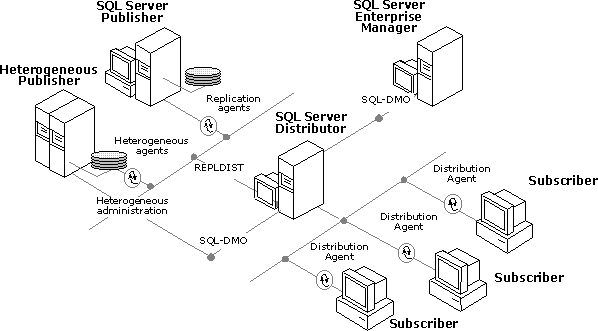
To integrate heterogeneous data sources with Microsoft® SQL Server™ replication, a developer can create a SQL-DMO program written in Microsoft Visual Basic®, C, or C++. A second program using the Replication Distributor Interface must be written in C or C++. The SQL-DMO program defines a publication, articles, and subscriptions. The C or C++ program then stores the replication transactions in the server acting as Distributor. After the publication, articles, and subscriptions are created, and the transactions are stored in the Distributor, the transactions are forwarded by the SQL Server Distribution Agent and can be monitored using Replication Monitor in SQL Server Enterprise Manager.
By integrating with SQL Server replication, heterogeneous applications can inherit a full set of replication features, such as:
The programmable replication services available to heterogeneous Publishers include:
This diagram illustrates how a heterogeneous data source is integrated into the replication framework as a Publisher.

A sample Visual Basic SQL-DMO program demonstrates how to create a heterogeneous publication. It is provided in the \Mssql7\Devtools\Samples\Sqlrepl\Samppub\Sqldmo directory. A sample C program demonstrates how to implement the Replication Distributor Interface. It is provided in the \Mssql7\Devtools \Samples\Sqlrepl\Samppub\Repdist directory.
| Implementing Transactional and Snapshot Replication from Heterogeneous Databases | Replication Distributor Interface Reference |